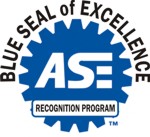 Our estimates are for complete jobs, done right the first time, that we can stand behind with our 24-month 24-thousand mile warranty. When people call for estimates on repair work, it can he hard to give our kind of estimate without seeing the vehicle itself. Here’s an article from one of our past newsletters about repair estimates. It explains why it’s in your interest to make an appointment for us to look at your vehicle before making any kind of estimate on repairs. We’d be glad to talk with you about your issues, and you can always email us a detailed question, but we may not be able to give you the clear estimate you want unless you schedule an appointment.
Our estimates are for complete jobs, done right the first time, that we can stand behind with our 24-month 24-thousand mile warranty. When people call for estimates on repair work, it can he hard to give our kind of estimate without seeing the vehicle itself. Here’s an article from one of our past newsletters about repair estimates. It explains why it’s in your interest to make an appointment for us to look at your vehicle before making any kind of estimate on repairs. We’d be glad to talk with you about your issues, and you can always email us a detailed question, but we may not be able to give you the clear estimate you want unless you schedule an appointment.
How Much Is THAT Gonna Cost?
Understanding estimates is key to wise spending
“As we know, there are known knowns; there are things we know we know. We also know there are known unknowns; that is to say we know there are some things we do not know. But there are also unknown unknowns — the ones we don’t know we don’t know.”
-Donald Rumsfeld
There is very little of lasting value from the Bush administration, but Donald Rumsfeld had a good point with his awkward thoughts on planning. Giving estimates for the cost of a job is one of the hardest things to do in any business. A client, understandably, wants to have at least SOME idea what they can expect to pay, but the service provider is being asked to predict an uncertain future and then stand by that prediction. One Portland automotive icon, Harold Dick, would banish clients who asked for an estimate. His feeling was that you were asking him to care for your car, so you should trust him to charge appropriately and be prepared to pay whatever it took to do it. Most businesses are a little more accommodating, though, and will give some estimate of what their work will cost. Estimates can be deceptive, either through intent or by accident. I hate to lose work to an incomplete or deceptive estimate provided by another business. I fear that in many cases that the services are not being compared accurately, and that ultimately they are delivered at a higher true cost, or not done right.
So what should you look for in a good estimate?
The dictionary defines estimate as “To judge tentatively or approximately the value, worth, or significance. To produce a statement of the approximate cost.” Simple enough, but then the questions start. Are you asking for a ballpark guess based on past experience or a detailed projection and evaluation based on current conditions? Is the estimate OK if it’s within 15%, or should it be the exact bottom line on the final bill? Should the estimate cover only certain items, or should it cover whatever it takes to do the job right? What happens to the estimate if something unplanned happens during the job?
Some states require estimates to be within 10% accuracy, but Oregon has no such requirement. Some Oregon shops even put disclaimers on their estimates that say the estimate can be off by stated percentages or dollar amounts without phone calls and the client still has to pay. If you run into this situation, be careful. If a shop is going to give you a number, you should at least know that it won’t change without warning. (We are within the estimate on 99.8% of our jobs, and we call for confirmation before proceeding when problems arise)
Where do estimates come from?
Most shops (including ours) create their estimates from a combination of previous experience and time-and-materials estimates from programs like Mitchell or AllData, databases that list parts and expected times for most vehicle repairs. You’d think it would be straightforward- all you do is read the numbers off the screen and you’re covered. But that’s exactly where the integrity, experience and goals of a Service Advisor comes into play.
First, the database time estimates are average times to complete individual, well-defined tasks. They’re guidelines, and don’t take into account things that could speed up or slow down the actual task in the real world. For instance, they assume the use of hand tools under normal conditions; no rust, no hidden damage, and everything installed to factory specifications. Database times don’t take into account the technician’s special tools, skills, or experience, nor do they cover unknowns (known or not) all of which can greatly impact the repair time.
Take advantage of overlapping labor
Database systems describe single tasks with some obvious additional related tasks as add-ons known as “combinations”. These combinations usually add minimal time to the core job because overlapping labor is accounted for. Some operations have logical additional tasks that can be done simultaneously to add reliability or to take advantage of the labor overlap for good long-term maintenance add-ons that are not listed as “combinations”. A good Service Advisor should offer these overlap discounts when possible. Not taking advantage of labor overlap is lost opportunity to save money on preventative maintenance. If you’re working on a big job, and an exposed part is predictably going to fail, you “might as well do it while you’re in there.”
For example, you know that all your vehicle’s hoses will eventually fail. Replacing a $10.00 bypass hose while the cylinder head is off only costs $25.00 because the labor to access and replace the hose is exposed from the cylinder head job. Sure, the $25.00 adds more to an already expensive job, but it’s money well spent. If that same hose fails later it will cost hundreds to replace, and you may also be left with a damaged engine, a tow bill, and a major inconvenience probably at the worst possible moment. Not taking advantage of overlapping labor is wasted money! I’ve seen people be charged for jobs done at separate times that could have been done together much more economically, taking advantage of the overlap in labor to save major money. An experienced and caring Service Advisor knows these overlaps and will suggest them. It’s not an up-sell; it makes good economic sense.
What kinds of estimates are there?
For illustrative purposes we will look at three kinds of estimates, based on the general intention of the person providing them. These aren’t hard-and-fast divisions, and there are definitely combinations of the types, but these general guidelines can be useful.
Bare-Bones Estimates– This is an estimate for the most basic job that can be done, covering the bare minimum parts and labor only. The cost estimate is given for a part and the labor to install that part, period.
A bare-bones estimate may not necessarily be deceptive or dishonest, but it can be very incomplete. It may estimate the “knowns” but ignore the “known unknowns”. Sometimes a bare-bones estimate is acceptable and a decent job can be done, but most repairs involve more and the client is usually looking for a job done RIGHT. An experienced Service Advisor knows the things that are likely to pop up during a given repair, and should include them upfront when estimating work needed. Bare-bones estimates don’t respect your hard-earned money because they fail to consider additional needed parts for a complete job, and will not cover or suggest other needed work that could be done inexpensively at the time rather than expensively later.
Upsale Estimates– These are Bare-Bones estimates given knowing full well they are incomplete and will require additional parts or labor. While an honest bare-bones estimate might strip out some of the “known unknowns” for economy, the Upsale estimate counts on the dreaded “Second Phone Call”. You brought the vehicle in based on a very attractive bare-bones estimate, but you’ll be at home or work when the phone rings. The Service Advisor (usually paid on commission) says “You know, we gave you that estimate for a new clutch disk at $499.95 but now we have the clutch apart and it looks like you also need the pressure plate, throw-out and pilot bearings, flywheel resurfacing, and clutch hydraulics. That’ll cost about $1200.00. Ya want us to take care of that now?” Ouch. Well, all those things added after the work was started are known unknowns and should have been included in the original estimate. Only a guy in his backyard would spend all the labor to remove the transmission and then replace just the clutch disk and call it a “clutch job”.
No one, no matter how skillful or honest, can plan for everything that can happen in an automotive repair. Once you’ve covered the knowns and planned for the known unknowns, the unknown unknowns can still pop up. There may be non-factory parts or options, a part may break due to unseen rust or damage, or previous work done may change the assumptions of the job. Sometimes that second phone call is for a very legitimate reason. No one likes the second or third calls, but they’re far preferable to not doing the job right or a giving you a huge surprise at the time of pickup.
Full Upfront Estimates– These are the kind of estimates we always give, and they are the most reliable type. These are estimates for a complete job, quality repair, long-term performance, and wise spending. They start with the “known knowns” of the job and then include the caveats and/or the prices for the “known unknowns”. Determining the known unknowns is primarily a matter of honest intentions, experience, research, and judgment. The type of vehicle, its mileage, repair history, the owner’s usage and driving habits all give clues to what level of service makes sense. A Full Upfront estimate covers a job done right, with all the known parts and labor processes accounted for, as well as the known unknowns needed to finish without a second call. Full Upfront estimates should also include discussions about the advantage of overlapping labor for preventative maintenance whenever it makes sense.
One downside of the Full Upfront estimate is the sticker shock that can come with it. Because our estimates cover all the logical bases, they’ll always be higher than a BareBones or the original Upsale estimate. It’s very frustrating to us when we give a Full Upfront Estimate to do a job right but we lose out to a lower number that is inaccurate or incomplete. When comparison shopping repairs and services, be sure to compare exact services; PLEASE don’t just ask “how much to replace my timing belt?” Ask; “When you replace my timing belt what will you do?” and then ask “how much for those services and what is the warranty?”
We will work with a client to find a less expensive solution if safe and viable options exist, but we will decline a job if economy trumps results. If we know something won’t work or is not in our client’s best interest we won’t do it. There is one caveat to this type of task negotiation- when we recommend a repair and the client chooses not to do it, we can’t be held responsible. “If the client dictates the recipe for the soup, we can’t be held responsible for how it tastes.” We have plenty of stories of recommending a repair, having the client decline it, and then having them blame us when the problem we predicted happens. We can’t (and certainly don’t want to) force people to do repairs, but it is still painful to hear: “you should have made me buy that!” Sometimes, there’s just no option but the right way.
Still sounds pretty iffy. Can you give me an example?
Glad you asked. One of the repairs that best illustrates the differences between types of estimates is the dreaded timing belt replacement. The timing belt is one of your vehicle’s most critical operational systems, so making sure it’s replaced before it breaks is pretty important. Timing belts are buried deep under the engine covers where there’s no easy or reliable way to examine them. Because we can’t accurately check their condition, timing belts are one of the vehicle systems that are appropriate to change on a time/mileage basis. Timing belts are good for 60,000 to 105,000 miles, or about ten years depending on the vehicle manufacturer’s recommendations.
So let’s pretend you drive a 2004 Honda Civic 4-cylinder that has 108,500 when you come in for an oil change. If it’s still the original timing belt (due at 110,000 miles) then it’s very likely we have already recommended a timing belt replacement and would remind you again at this point. For the sake of this example let’s assume you’d agree to the repair but ask the classic question “How much is THAT gonna cost?” A Service Advisor’s first step would be to go to the computer and pull up the basic repair. Here’s what the screen would look like…

The database indicates that changing the timing belt on a ’04 Civic takes 3 hours. Labor rate in this example is $97.35/hr, for a labor total of $292.05. We’ll need one timing belt at $22.75, and there’s $18.50 in fees for a total of $333.30.
This is good, solid information and it provides everything needed for a BareBones estimate. It covers the minimum job, and when a client asks “How much to do a timing belt?” it’s a completely honest answer. However, the list is far from complete. To do the timing belt replacement as it may need to be done to insure a long-term result and take advantage of all the overlapping labor savings, the estimate for a Civic should include the bare-bones list plus some or all of these items: water pump, external belt, cam seals, crank seal, timing belt tensioner and idler bearings, valve cover gasket and grommets, spark plug seals, thermostat and cooling system supplies.
Doing the timing belt with these additional parts and labors insures that you won’t be paying the $300 dollars in labor to go back under the timing cover again soon for a problem. The complete job including the list of additional parts would cost significantly more but covers much more as well; timing belt replaced with seals and tensioners, water pump replaced with thermostat and cooling system service (also any needed hoses could be replaced at this time for the cost of parts and minimal labor), resealing the valve cover (that needs to be loosened or removed to pull the timing cover off) and checking the valve clearance (with the cover off now is the time to do a valve adjustment).
Any Up Front estimate will include all these elements (or at least discussions about them) because although they may not be critical needs right now, it makes sense to do them for little or no labor with the timing belt overlap. So let’s see what happens when we add all these new recommendations.

Wow. Now we’re up to $921.77. It’s a heck of a change from the original Bare-Bones estimate of $333.30, but look how the numbers break down. The labor has only gone up $214.17, and all the rest is parts! Rather than inappropriately doing the timing belt alone, we have performed six needed maintenance services economically and correctly:
Timing belt replaced with all wearing components
All front engine oil seals replaced
Valves adjusted and cover resealed
Water pump and thermostat replaced
Cooling system flushed, filled and pressure tested.
External Drive belt replaced
All of this extra work was done to take advantage of combinations or overlaps. If it was done later (and most of it would need to be done well before the next timing belt interval) it could risk engine damage and would be done with substantially higher labor charges. Because many of these wearing items are under the timing cover, later replacement would start out by paying the near 3 hours of labor just to regain access.
Here’s a final example that might shed some light on the difference between Bare Bones and honest Up Front estimates. It’s the difference between estimating the bare minimum to get the job versus estimating the job completely with the known unknowns included to do it right the first time. One good example of poor service and loss of value (aka rip-off) I have had a client tell me about was this: This client had a timing belt done at the dealer and was given no discussion about covering the combinations or overlapping labors. 10,000 miles later, the same dealership tried to sell the client a cam seal (which lives behind the timing belt) for $350.00. When asked why it was needed, the client was told that they often leak and that it was a preventative measure. That’s pretty sad when the seal (which wasn’t currently leaking) could have been replaced preventatively when the timing belt was replaced as a combination for an additional .3 hours labor and a $10 dollar seal (probably $35.00 total). Not offering the sensible combinations and overlaps was bad enough on the original visit, but trying to resell the labor that 100% overlapped on the original job is criminal, incompetent or negligent at best. Most consumers have no basis for understanding combinations and overlapping labors and might expect some help there.
What ELSE could go wrong?
Another issue is the one that can destroy even the best, most in-depth estimate. It’s the one that no one can predict: the totally unexpected things that can pop up despite the most earnest efforts and worldly experience, Rumsfeld’s “unknown unknowns.” No one likes these; neither client nor shop, but the Bare Bones and Up Sell methods don’t seem to worry much about it. They make that second call and point out (correctly) that this was unanticipated and outside the scope of their estimate; how would you like to pay? The second call bothers us a little more since our estimate was supposed to cover all contingencies from the beginning, but the unexpected does happen and when it does we make that call too. Here are just a few issues that can make the phone ring (legitimately) the second dreaded time:
- Unusual or hidden damage– You might expect a particular type of damage as a part fails, but it might have failed in an unexpected way or damaged another system that it wouldn’t normally affect. The damage wouldn’t be known until after the repair was started.
- Prior work issues- Sometimes people try to work on their own cars with mixed results. There might be parts missing or added, or entire systems could be reassembled in new and exciting ways that the manufacturer never intended. Our techs are top-of-the-line but they are trained to deal with factory correct vehicles. We can’t plan for how long it will take to unwind someone else’s mechanical creativity.
- Missing or broken fasteners– Ever heard the poem “For want of a nail the horse was lost…?” Estimates assume that all of the parts are there for reassembly, but a little plastic fastener that’s broken or gone can ruin the day.
- Hidden leaks- Timing cover leaks, head gasket failures, intake manifolds, covered oil seals. Visibility is much greater after things are apart. The source of leaks can be hard to pin down and it doesn’t do any good to put you back on the road still leaking.
- Broken / rusted/ seized fasteners– If a bolt or stud is rusted or broken, depending on access, it can take hours of work with specialized tools for replacement or removal without doing further damage.
- Engine ID parts problems- When the parts are ordered for the repair; it’s based on the assumption that the engine and main parts are the proper ones for the vehicle. Repairs from accidents or installation of rebuilt engines and drive train components can mean the parts we order may be proper for your year and model car may not fit your particular car.
Sometimes parts break because they are old and crusty, and sometimes they break through legitimate accidents or inattention. We have a general rule that’s fair to both the client and our shop… if things break when coming apart it’s the client’s responsibility, but if it there is a problem going back together it’s our problem. If something breaks coming apart we’ll call you to change the estimate, but if it things fail going back together we will smile and make it right without complaining and add the experience to our database.
So what’s the bottom line?
That’s a lot to know about estimates, but the basics boil down pretty simply. When getting an estimate for auto repair (or any similar type job)…
- Make sure that estimates covers all the parts and labor for a complete job done well.
- Make sure all work is covered under a good warranty.
- If you get a series of phone calls with increases and surprises after an estimate; ask questions.
- It’s OK to limit spending, but be careful. If something goes wrong, remember who made the decisions.
A friend once joked with me, saying “you’d make more money if you didn’t fix everything so good the first time”. He was right; many shops thrive on repeat business, but the kind of repeat is the question. I won’t profit by charging twice for operations that should have been done right the first time. When we make estimates we always give you the most accurate “…statement of the approximate cost” for finished work done right. We tell you about the knowns and we warn you about any likely known unknowns or include them in the estimate. We will also take the time to talk with you about the possible advantages of overlapping labor for your particular repair. If you can save money or add reliability by logical job sequencing we’ll let you know. We are always looking out for your long-term best interest, not just the short-term profits. Our estimates are for complete jobs done right the first time that we can stand behind with our 24-month 24-thousand mile warranty. Our estimates are always as complete and accurate as possible, and you shouldn’t expect anything less from any company you deal with.










